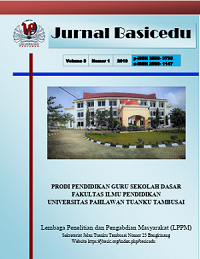Improving Students’ Reading Comprehension By Using the Orthographic Method for Elementary Students’
DOI:
https://doi.org/10.31004/basicedu.v8i4.8575Abstract
Unfortunately, many people experience reading difficulties, affecting their educational attainment and overall quality of life. Addressing this challenge has been a focus of researchers, educators and policymakers for decades. This research aims to determine the impact of the orthographic method on the development of reading comprehension in grade 4 students. The research design used was a pre-experimental method with a pre-test and post-test research design. Researchers used quantitative research methods with a pre-experimental planning strategy to determine the influence of the Orthographic Method on students' inspiration to learn English comprehension. A total of 40 sample students were selected as the sample for this research. The main components of data collection techniques are tests that are used to evaluate students' progress towards learning goals and their abilities can be seen as an evaluation tool in this context. The researchers used a research method called one-group pre-tested posttest design and compared the differences between the pretest and posttest. The results of this research there is a significant improvement in teaching using the orthographic method on students' reading comprehension in test subjects. This means that the Orthographic method activates students' existing knowledge about the topic, provides opportunities for the topic and gives students the opportunity to engage with the topic
References
Agustina, M. W. (n.d.). Pengaruh Phonological Awaraness dan Kemampuan Pemrosesan Orthografi Siswa Sekolah Dasar. https://www.researchgate.net/publication/307773682 Pengaruh Phonological Awareness dan Kemampuan Pemrosesan Orthografi Terhadap Kemampuan Membaca Awal Siswa Sekolah Dasar
Anastasiou, D., & Griva, E. (2009). Awareness of reading strategy use and reading comprehension among poor and good readers. 8(2), 283–297. https://core.ac.uk/download/pdf/230030801.pdf
Aro, M. (2014). Mikko Aro LEARNING TO READ The Effect of Orthography (Issue January 2004). https://www.researchgate.net/publication/230735268_Learning_to_read_The_effect_of_orthography
Baird, L. (2004). Persoalan Orthografi Dalam Bahasa Daerah di Alor dan Pantar. Journal Masyarakat Linguistik Indonesia 3, 1–22. http://www.marianklamer.org/uploads/1/2/4/7/124768088/baird_klamer_orthograpy_issues.pdf
Bhargav, G. P. S., Glass, M., Garg, D., Shevade, S., Dana, S., Khandelwal, D., Subramaniam, L. V., & Gliozzo, A. (2019). Translucent Answer Predictions in Multi-Hop Reading Comprehension. https://doi.org/10.1609/aaai.v34i05.6272
Chrabaszcz, A., Gebremedhen, N. I., Alvarez, T. A., Durisko, C., & Fiez, J. A. (2023). Orthographic learning in adults through overt and covert reading. Acta Psychologica, 241(November), 104061. https://doi.org/10.1016/j.actpsy.2023.104061
Fadillah, S., & Amin, T. S. (2021). Improving students’ reading comprehension achievement through wattpad media of eleventh grade At SMA Swasta Bandung. Cybernetics: Journal Educational Research and Sosial Studies, 3(1), 1–10. https://pusdikra-publishing.com/index.php/jrss/article/view/365
Harsanti, H. R. (2020). The Use of Orthography to Increase Young Learners’ Basic Literacy: Spelling Ability. ELT Worldwide: Journal of English Language Teaching, 7(2), 89. https://doi.org/10.26858/eltww.v7i2.13859
Kaani, B., & Joshi, R. M. (2023). Acquiring Reading Skills in Languages with Varying Orthographic Depth?: A Case of Cinyanja-English Bilinguals in Zambia. 7(2), 63–84. https://humanities.unza.zm/index.php/jlt/article/view/1139
Kilag, O. K. T., & Esdrelon, K. G. N. (2023). Advancing Reading Skills?: State-of-the-Art Remediation Strategies. 1(1), 15–29. https://www.researchgate.net/publication/374923779_Advancing_Reading_Skills_State-of-the-Art_Remediation_Strategies
Kochva, I. B., Vágvölgyi, R., Dresler, T., Nagengast, B., Schröter, H., & Schrader, J. (2021). Basic reading and reading ? related language skills in adults with deficient reading comprehension who read a transparent orthography. Reading and Writing, 34(9), 2357–2379. https://doi.org/10.1007/s11145-021-10147-4
Mariska Okkinga, Roel van Steensel, Amos J. S. van Gelderen, P. J. C. S. (2016). Effects of reciprocal teaching on reading comprehension of low-achieving adolescents. The importance of specific teacher skills. https://doi.org/https://doi.org/10.1111/1467-9817.12082
Mather, N., & Jaffe, L. (2021). Orthographic Knowledge is essential for reading and spelling. The Reading League Journal, 2(3), 15–25.
Milankov, V., Golubovi?, S., Krsti?, T., & Golubovi?, Š. (2021). Phonological awareness as the foundation of reading acquisition in students reading in transparent orthography. International Journal of Environmental Research and Public Health, 18(10). https://doi.org/10.3390/ijerph18105440
Muh, A., Afiz, F., Korompot, C. A., & Talib, A. (2024). Correlation between English education Students ’ Reading Comprehension and Their Writing Skills. 3(1), 140–151. https://ojs.unm.ac.id/JoEELE/index
Neuroscience, H., Wang, H., Marinus, E., Nickels, L., & Castles, A. (2014). Tracking orthographic learning in children with different profiles of reading difficulty. 8(July), 1–14. https://doi.org/10.3389/fnhum.2014.00468
Noermanzah, N., & Bengkulu, U. (2019). Improvement Of Reading Comprehension Ability By Using Core Models Of Class Vii A Students Of Smp Negeri 10 Bengkulu Tengah. December. https://www.researchgate.net/publication/337997908_Improvement_Of_Reading_Comprehension_Ability_By_Using_Core_Models_Of_Class_Vii_A_Students_Of_Smp_Negeri_10_Bengkulu_Tengah
Ouellette, G., & Daal, V. Van. (2017). Scientific Studies of Reading Introduction to the Special Issue . Orthographic Learning and Mental Representations in Literacy?: Striving for a Better Understanding of a Complex Lead Role Introduction to the Special Issue . Orthographic Learning and Menta. Scientific Studies of Reading, 21(1), 1–4. https://doi.org/10.1080/10888438.2016.1254635
Panah, M. A. (2012). Cognitive processes of learning to read in Persian orthography. Procedia - Social and Behavioral Sciences, 32(2011), 339–343. https://doi.org/10.1016/j.sbspro.2012.01.050
Sari, M. H., Eka, D., & Wardhana, C. (2020). Understanding the Level of Students ’ Reading Comprehension Ability. May. https://doi.org/10.31219/osf.io/mr62t
Downloads
Published
How to Cite
Issue
Section
Citation Check
License
Copyright (c) 2024 Nanda Armelia, Isnaniah Isnaniah, Hery Nuraini

This work is licensed under a Creative Commons Attribution-ShareAlike 4.0 International License.
Authors who publish with this journal agree to the following terms:
- Authors retain copyright and grant the journal right of first publication with the work simultaneously licensed under a Creative Commons Attribution License that allows others to share the work with an acknowledgement of the work’s authorship and initial publication in this journal.
- Authors are able to enter into separate, additional contractual arrangements for the non-exclusive distribution of the journal’s published version of the work (e.g., post it to an institutional repository or publish it in a book), with an acknowledgement of its initial publication in this journal.
- Authors are permitted and encouraged to post their work online (e.g., in institutional repositories or on their website) prior to and during the submission process, as it can lead to productive exchanges, as well as earlier and greater citation of published work (See The Effect of Open Access).



